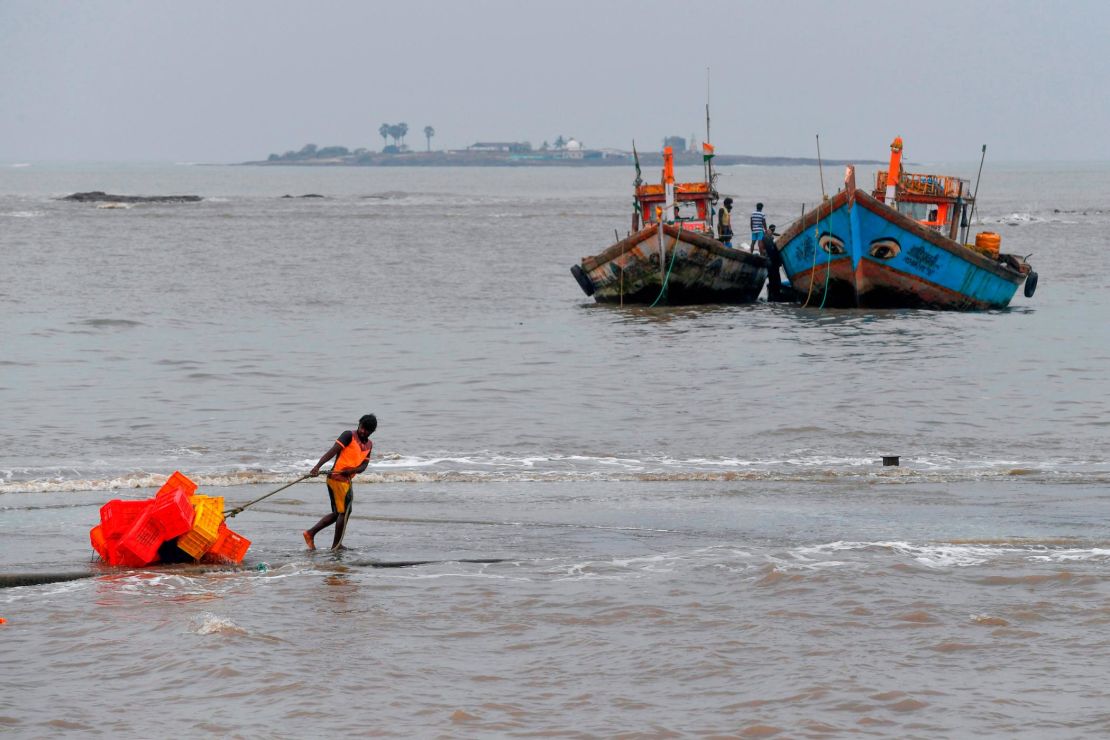Coronavirus patients were among more than 100,000 people evacuated from low-lying coastal areas in India’s western states as a cyclone made landfall near Mumbai on Wednesday.
India’s financial center avoided the worst of Cyclone Nisarga, which made landfall at around 1 p.m. local time (3:30 a.m. ET), according to the Indian Meteorological Department (IMD). The cyclone, which formed in the Arabian sea on Tuesday morning, hit Alibag town, south of Mumbai.
At least one person was killed during the storm. A 58-year-old man died after an electrical transformer fell on him in Raigad, a district in India’s Maharashtra state, according to a senior National Disaster Response Force (NDRF) official.
“So far this is the only death reported in the state and we have begun [a] restorations operation this evening as soon as the cyclone passed,” NDRF Commandant in Maharashtra Anupam Srivastava told CNN.
The region saw wind speeds up to 130 kph (81 mph), Srivastava told CNN earlier, but added that damage in Maharashtra was minimal.
“Apart from tin roofs flying off and treefall there isn’t much damage in the state and we expect to clear the roads by tomorrow,” he said.
The official earlier said that up to 40 trees were uprooted, some of which fell on the Mumbai Pune expressway.
A 40 km (24 mile) stretch from Raigad to Alibag received the brunt of the damage – where winds stripped buildings of tin roofs and a small number of trees fell on houses.
“The tail of the cyclone is currently passing over Alibag after which wind speeds will drop, once it is cleared our teams will go in to assess the extent of damage and begin restoration,” Srivastava said.
Cyclones in that part of India are relatively rare – Mumbai, which is home to 18 million people, was last hit by a major storm in 1948.
The arrival of Cyclone Nisarga on Wednesday came as Maharashtra grapples with India’s worst coronavirus outbreak. Hospitals are struggling to treat an influx of patients as the confirmed number of cases in that state passes 72,300, with more than 2,400 deaths.
Ahead of landfall, the cyclone strengthened to the equivalent of just below a Category 1 Atlantic hurricane, or a Severe Cyclonic Storm in the West Pacific.
The states of Maharashtra and Gujarat, and the Union Territories of Dadra and Nagar Haveli, and Daman and Diu along India’s west coast were expected to be the worst affected by the storm. Officials were concerned that intense rainfall could lead to deadly flooding in and around Mumbai and surrounding areas of Maharashtra and Gujarat.
Storm surges of approximately one to two meters (3.3 to 6.6 foot) are likely to inundate low-lying areas of Mumbai, Thane and Raigad districts, the IMD said.
But the cyclone appears to have caused only minimal damage in Gujarat, according to the state’s Relief Commissioner Harshad Patel.
“There was no damage to property or loss of life [in Gujarat], only 152 electrical poles fell which caused some problems in electricity but they are being restored,” Patel told CNN.
Over 65,000 people who were evacuated from the coastal regions of Gujarat ahead of the cyclone and are now being sent home.
“People had been requesting to go home since the cyclone has passed so we have told the district officials that those who want to go home can do so as it is safe and clear,” Patel added.
Evacuating coronavirus patients
In Maharashtra, a state which has struggled to contain coronavirus, about 1,000 patients with suspected Covid-19 were evacuated from a field hospital on Tuesday and taken to other facilities.
The Maharashtra government set up several “jumbo facilities” to act as isolation centers for suspected coronavirus cases.
“The sheds can easily withstand the rain but it is the wind speed that I am worried about and I don’t want to endanger anyone,” Uddhav Thackeray, the chief minister of the state said in an address on Tuesday.
The field hospital in Bandra Kurla Complex in Mumbai has capacity for over 1,000 patients, all of whom are being shifted to other hospitals, he added.

Ahead of landfall, India’s National Disaster Response Force (NDRF) deployed 20 teams in Maharashtra, 16 teams in Gujarat, and two teams in other nearby areas.
Thousands of people living in flimsy or makeshift homes along the low-lying coast have been evacuated, according to a statement from the Indian Ministry of Home Affairs.
Around 60,000 people were evacuated from coastal regions in Maharashtra ahead of the cyclone according to Kisor Nibalkar, the state relief commissioner.
Mumbai’s civic body, the Brihanmumbai Municipal Corporation (BMC) said 35 schools were being used as temporary evacuation shelters for citizens.
Indian Prime Minister Narendra Modi urged residents in affected areas to take all possible precautions.
“Took stock of the situation in the wake of cyclone conditions in parts of India’s western coast. Praying for everyone’s well-being. I urge people to take all possible precautions and safety measures,” Modi said in a tweet on Tuesday.
Tropical Cyclone Nisarga comes two weeks after powerful Cyclone Amphan slammed into India’s eastern coast, killing at least 90 people in India and neighboring Bangladesh, leaving millions without power, and causing more than $13.2 billion dollars in damage.
CNN’s Brandon Miller contributed to reporting.

